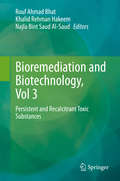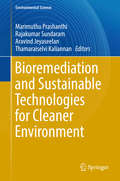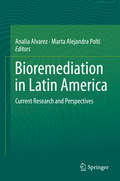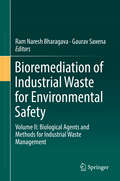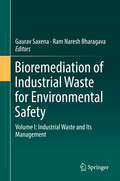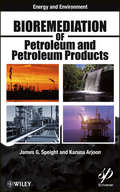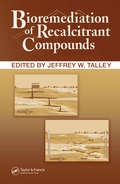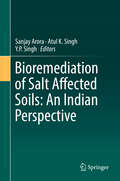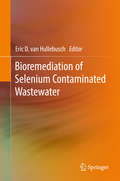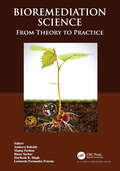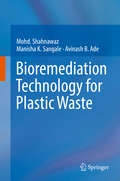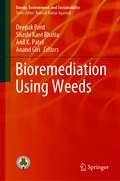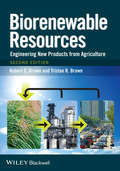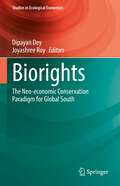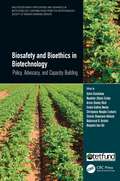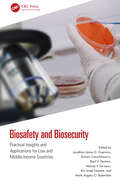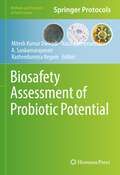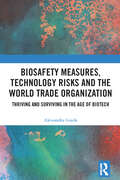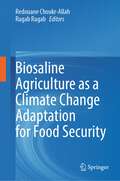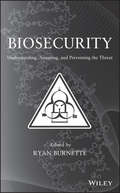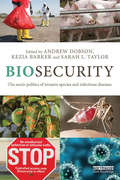- Table View
- List View
Bioremediation and Biotechnology, Vol 3: Persistent and Recalcitrant Toxic Substances
by Rouf Ahmad Bhat Khalid Rehman Hakeem Najla Bint Saud Al-SaudHealthy environment is important for any kind of biota on earth. It provides the basic elements of life such as clean water, fresh air, fertile soil and supports ecosystem of the food chain. Pollution drastically alters quality of the environment by changing the physico-chemical and biological aspects of these components. Accordingly, toxic metals, combustible and putrescible substances, hazardous wastes, explosives and petroleum products are all examples of inorganic and organic compounds that cause contaminations. Specifically, pollution of toxic and heavy metal in the environment is a growing problem worldwide, currently at an alarming rate. Toxic metals threaten the aquatic ecosystems, agriculture and ultimately human health. Traditional treatment techniques offer certain advantages such as rapid processing, ease of operation and control and flexibility. But, they could not maintain the quality of the environment due to the high operational costs of chemicals used, high energy consumption and handling costs for sludge disposal and overburden of chemical substances which irreversibly affect and destroy biodiversity, which ultimately render the soil useless as a medium for plant growth. Therefore, bioremediation and biotechnology, carried out by living assets to clean up, stabilize and restore contaminated ecosystems, have emerged as promising, environmental friendly and affordable approaches. Furthermore, the use of microbes, algae, transgenic plants and weeds adapted to stressful environments could be employed to enhance accumulation efficiency. Hence, sustainable and inexpensive processes are fast emerging as a viable alternative to conventional remediation methods, and will be most suitable for developing countries.In the current volume, we discuss pollution remediation challenges and how living organisms and the latest biotechnological techniques could be helpful in remediating the pollution in ecofriendly and sustainable ways.
Bioremediation and Sustainable Technologies for Cleaner Environment (Environmental Science and Engineering)
by Marimuthu Prashanthi Rajakumar Sundaram Aravind Jeyaseelan Thamaraiselvi KaliannanThis book offers insights into the current focus and recent advances in bioremediation and green technology applications for waste minimization and pollution control. Increasing urbanization has an impact on the environment, agriculture and industry, exacerbating the pollution problem and creating an urgent need for sustainable and green eco-friendly remediation technology. Currently, there is heightened interest in environmental research, especially in the area of pollution remediation and waste conversion, and alternative, eco-friendly methods involving better usage of agricultural residues as economically viable substrates for environmental cleanup are still required. The book offers researchers and scholars inspiration, and suggests directions for specific waste management and pollution control. The research presented makes a valuable contribution toward a sustainable and eco-friendly societal environment.
Bioremediation in Latin America: Current Research and Perspectives
by Analía Alvarez Marta Alejandra PoltiThe book compiles an update information about the state of bioremediation in emerging Latin American countries. Some of the studied regions are sites that suffered decades of pollution by agrochemicals, heavy metals and industrial waste due to the lack of control by government regulations. Such is the case of Northern Argentina, where were illegally deposited over 30 tn of obsolete organochlorine pesticides in 1994. The content has focused in the use of native organisms (from bacteria to plants) as a viable solution to the problem of pollution, using low-cost and powerful techniques, socially well accepted and appropriate from the environmental point of view. In this context, levels of pesticide found in the Latin American population are informed. It was also displayed as a multidisciplinary approach based on concerns of a diverse group of researchers (biochemists, biologists, chemical engineers and geneticists) about a global problem, dealing with specific cases of study, with a view to project their findings to worldwide. In this regard, researchers provide their findings to regulatory sectors, whom could make appropriate decisions.
Bioremediation of Agricultural Soils
by Juan C. Sanchez-HernandezThe quality of agricultural soils are always under threat from chemical contaminants, which ultimately affect the productivity and safety of crops. Besides agrochemicals, a new generation of substances invades the soil through irrigation with reclaimed wastewater and pollutants of organic origin such as sewage sludge or cattle manure. Emerging pollutants such as pharmaceuticals, nanomaterials and microplastics are now present in agricultural soils, but the understanding of their impact on soil quality is still limited. With focus on in situ bioremediation, this book provides an exhaustive analysis of the current biological methodologies for recovering polluted agricultural soils as well as monitoring the effectiveness of bioremediation.
Bioremediation of Contaminated Soils (Environmental Science & Pollution)
by Donald L. WiseThis volume focuses on innovative bioremediation techniques and applications for the cleanup of contaminated media and sites. It includes quantitative and design methods that elucidate the relationships among various operational parameters, and waste chemistry that defines the cost effectiveness of bioremediation projects. It also presents numerica
Bioremediation of Industrial Waste for Environmental Safety: Volume II: Biological Agents and Methods for Industrial Waste Management
by Ram Naresh Bharagava Gaurav SaxenaAchieving environmental sustainability with rapid industrialization is currently a major global challenge. Industries are the key economic drivers, but are also the main polluters as untreated/partially treated effluents from industry are usually discharged into the aquatic environment or dumped. Industrial effluents often contain highly toxic and hazardous pollutants, which cause ecological damage and present and health hazards to living beings. As such, there is a pressing need to find ecofriendly solutions to deal with industrial waste, and to develop sustainable methods for treating/detoxifying waste before it’s released into the environment. As a low cost and eco-friendly clean technology, bioremediation can offer a sustainable alternative to conventional remediation technologies for the treatment and management of industrial wastes. This book (Volume II) describes the role of biological agents in the degradation and detoxification of organic and inorganic pollutants in industrial wastes, and presents recent bioremediation approaches for waste treatment and management, such as constructed wetlands, electro- bioremediation and nano-bioremediation, as well as microbial fuel cells. It appeals to students, researchers, scientists, industry professionals and experts in the field of microbiology, biotechnology, environmental sciences, eco-toxicology, environmental remediation and waste management and other relevant areas who are interested in biodegradation and bioremediation of industrial wastes for environmental safety.
Bioremediation of Industrial Waste for Environmental Safety: Volume I: Industrial Waste and Its Management
by Gaurav Saxena Ram Naresh BharagavaAchieving environmental sustainability with rapid industrialization is a major challenge of current scenario worldwide. As globally evident, industries are the key economic drivers, but are also the major polluters as untreated/partially treated effluents discharged from the industries is usually thrown into the aquatic resources and also dumped unattended. Industrial effluents are considered as the major sources of environmental pollution as these contains highly toxic and hazardous pollutants, which reaches far off areas due to the medium of dispersion and thus, create ecological nuisance and health hazards in living beings. Hence, there is an urgent to find ecofriendly solution to deal with industrial waste, and develop sustainable methods for treating/detoxifying wastewater before its release into the environment. Being a low cost and eco-friendly clean technology, bioremediation can be a sustainable alternative to conventional remediation technologies for treatment and management of industrial wastes to protect public health and environment. Therefore, this book (Volume I) covers the bioremediation of different industrial wastes viz. tannery wastewater, pulp and paper mill wastewater, distillery wastewater, acid mine tailing wastes, and many more; which are lacking in a comprehensive manner in previous literature at one place. A separate chapter dedicated to major industries and type of waste produced by them is also included. This book will appeal to students, researchers, scientists, industry persons and professionals in field of microbiology, biotechnology, environmental sciences, eco-toxicology, environmental remediation and waste management and other relevant areas, who aspire to work on the biodegradation and bioremediation of industrial wastes for environmental safety.
Bioremediation of Petroleum and Petroleum Products
by Karuna K. Arjoon James G. SpeightWith petroleum-related spills, explosions, and health issues in the headlines almost every day, the issue of remediation of petroleum and petroleum products is taking on increasing importance, for the survival of our environment, our planet, and our future. This book is the first of its kind to explore this difficult issue from an engineering and scientific point of view and offer solutions and reasonable courses of action.
Bioremediation of Recalcitrant Compounds
by Jeffrey W. TalleyThis authoritative text addresses the latest in bioremediation technologies for three difficult-to-treat contaminant groups: chlorinated solvents, PCBs, and PAHs - one of the most complex and expensive areas of applied remediation engineering.Bioremediation of Recalcitrant Compounds assesses innovative R&D projects developed for each contam
Bioremediation of Salt Affected Soils: An Indian Perspective
by Sanjay Arora Atul K. Singh Y. P. SinghThis edited volume focuses on the characterization, reclamation, bioremediation, and phytoremediation of salt affected soils and waterlogged sodic soils. Innovative technologies in managing marginal salt affected lands merit immediate attention in the light of climate change and its impact on crop productivity and environment. The decision-making process related to reclamation and management of vast areas of salt affected soils encompasses consideration of economic viability, environmental sustainability, and social acceptability of different approaches. The chapters in this book highlight the significant environmental and social impacts of different ameliorative techniques used to manage salt affected soils. Readers will discover new knowledge on the distribution, reactions, changes in bio-chemical properties and microbial ecology of salt affected soils through case studies exploring Indian soils. The contributions presented by experts shed new light on techniques such as the restoration of degraded lands by growing halophyte plant species, diversification of crops and introduction of microbes for remediation of salt infested soils, and the use of fluorescent pseudomonads for enhancing crop yields.
Bioremediation of Selenium Contaminated Wastewater (Springerbriefs In Molecular Science)
by Eric D. HullebuschThis book features the reduction and removal of selenium in wastewater via bioremediation. Arranged over five chapters, this book provides information regarding the interaction between micro-organisms and selenium, and it also explains the biogeochemistry of selenium in engineered ecosystems designed for wastewater treatment. The analytical approaches currently adopted by the scientific community are also described and discussed. Readers will find examples of the biological treatment of selenium contaminated wastewater, and discover a concise overview of selenium removal processes that are currently implemented at lab-scale as well as at industrial scale.
Bioremediation Science: From Theory to Practice
by Amitava Rakshit, Manoj Parihar, Binoy Sarkar, Harikesh B. Singh and Leonardo Fernandes FracetoThis book provides state of the art description of various approaches, techniques and some basic fundamentals of bioremediation to manage a variety of organic and inorganic wastes and pollutants present in our environment. A comprehensive overview of recent advances and new development in the field of bioremediation research are provided within relevant theoretical framework to improve our understanding for the cleaning up of polluted water and contaminated land. The book is easy to read and language can be readily comprehended by aspiring newcomer, students, researchers and anyone else interested in this field. Renowned scientists around the world working on the above topics have contributed chapters. In this edited book, we have addressed the scope of the inexpensive and energy neutral bioremediation technologies. The scope of the book extends to environmental/agricultural scientists, students, consultants, site owners, industrial stakeholders, regulators and policy makers.
Bioremediation Technology: Hazardous Waste Management
by M. H. Fulekar Bhawana PathakThe book describes hazardous waste industries, sources of waste generation, characterization and treatment processes/ methods and technique and technology to deal with the treated waste as per the prescribed standard. Advanced treatment based on the microbial remediation, plant-based decontamination, rhizoremediation and nano-based remediation is also explained. Advances in treatment technology using biotechnological tools/bionanotechnology for removal of contaminants are described. This volume will help readers to develop biotechnological and nanotechnological approaches for the remediation of hazardous waste and the developed technology that can be transferred from laboratory to land and piloting to commercial scenarios. Prof. M. H. Fulekar a Professor and Joint Director (R&D), Centre of Research for Development, Parul University. Dr. Bhawana Pathak is working as an Associate Professor and Dean in School of Environment and Sustainable Development, Central University of Gujarat.
Bioremediation Technology for Plastic Waste
by Mohd. Shahnawaz Manisha K. Sangale Avinash B. AdePlastic is one of the widely used polymers around the globe since its discovery. It is highly impossible to think the ease of life without the aid of plastic. Every year billion tons of plastic waste gets accumulated in the environment and leads to death of both marine and terrestrial animals. Plastic is very durable and needs around 1000 years to degrade under the natural environment. The present book illustrates the importance and significance of the bioremediation to tackle the problem of plastic waste. Previously, we have reported elite rhizobacterial isolates (Lysinibacillus fusiformis strain VASB14/WL and Bacillus cereus strain VASB1/TS) of Avicennia marina Vierh (Forsk.) from the West Coast of India with the potential to degrade plastic (polythene). The present book attempted to address the bioremediation scenario of plastic waste (including micro plastic) using microbes with bacteria in particular. Various strategies used to tackle with the plastic waste were highlighted with case studies of plastic waste management, including in vitro, in situ and ex situ with a special reference to biodegradation technology. After the biodegradation of the plastic using microbes, the generated plastic (polythene) degradation products (PE-DPs) were also documented using GC-MS technique followed by their deleterious effect on both animal and plant systems. The book also enhances the awareness of the plastic-free society and also suggests some alternative materials to be used instead of plastic. Lastly, the book suggests/recommends the strategies to be followed by the lawmakers in the government organizations/non-government organizations/social organizations to frame the regulations and guidelines to implement at mass level to reduce the generation of plastic waste.
Bioremediation using weeds (Energy, Environment, and Sustainability)
by Deepak Pant Shashi Kant Bhatia Anil K. Patel Anand GiriIn this monograph, the core elements of multidisciplinary bioremediation practices are addressed and environmental pollutants which can be effectively remediated using weeds is focused upon. Weeds plants can easily grow in waste dumping sites with their rapidly colonizing ability. The contents include recent results in bioremediation and focuses on the current trend of introduction of potentials of weeds in bioremediation practice. This volume will be a useful guide for researchers, academics and scientists.^
Biorenewable Resources
by Tristan R. Brown Robert C. BrownBiorenewable Resources: Engineering New Products from Agriculture, 2nd Edition will provide comprehensive coverage of engineering systems that convert agricultural crops and residues into bioenergy and biobased products. This edition is thoroughly updated and revised to better serve the needs of the professional and research fields working with biorenewable resource development and production. Biorenewable resources is a rapidly growing field that forms at the interface between agricultural and plant sciences and process engineering. Biorenewable Resources will be an indispensable reference for anyone working in the production of biomass or biorenewable resources.
Bioresource Utilization and Bioprocess
by Sadhan Kumar Ghosh Agamuthu Pariatamby Ramakrishna Sen H. N. ChanakyaThis book focuses on the utilization of bio-resources and their conversion pathways for a sustainable future. Tapping into bio-resources by means of thermochemical and biochemical processes has attracted researchers from all over the world; it is a broad area that has given birth to concepts like the biorefinery, as well as a new stream known as biotechnology. Its scope includes biochemical and microbiological engineering, biocatalysis and biotransformation, biosynthesis and metabolic engineering, bioprocess and biosystem engineering, bioenergy and biorefineries, cell culture and biomedical engineering, food, agricultural and marine biotechnology, bioseparation and biopurification engineering, bioremediation and environmental biotechnology, etc. The book discusses a host of new technologies now being used to tap these resources with innovative bioprocesses. All chapters are based on outstanding research papers selected for and presented at the IconSWM 2018 conference.
Biorights: The Neo-economic Conservation Paradigm for Global South (Studies in Ecological Economics #7)
by Dipayan Dey Joyashree RoyThis book evaluates local conservation successes of global south in the climate milieu, as an empirical evidence of ‘Bio-rights’ of commons at community-ecosystem interface for sustainable intensification of nature’s goods and services. Bio-rights is a right-based neo-economic conservation paradigm that compensates the opportunity costs incurred in conservation efforts by the marginal communities, living near globally important ecosystems and dependent on it for their livelihood, through payments from environment services. The book would bring forth the true value of circular economic interventions in socio-ecological conservation, shaped through sustainable human interactions with nature. This multilevel study of conservation science serves an interdisciplinary academia, consistent with conventions on climate change, bio-diversity and sustainable development, to establish links between conservation priorities and development objectives. Herein, Bio-rights is introduced as a ‘design approach’ for production linked sustainable development, supplemented with case studies from the east.
Biosafety and Bioethics in Biotechnology: Policy, Advocacy, and Capacity Building (Multidisciplinary Applications and Advances in Biotechnology)
by Sylvia UzochukwuThis book covers a range of important topics in biotechnology policy, advocacy and education, bioethics, biosafety regulations for genetically modified organisms and gene-edited products and biotechnology manpower development. Throughout the book, the contributors review biosafety and bioethical guidelines that could enhance adoption of biotechnology in alignment with national priorities and research agendas. They also discuss the importance of current biotechnology policy advocacy, enlightenment and public engagement with stakeholders and policy makers. The book will be useful reference material for scientists and researchers working in the fields of food and agricultural biotechnology, biopharmaceuticals and medical biotechnology, environmental biotechnology, biotechnology policy and advocacy, biotechnology communication and manpower development, biosafety and bioethics, etc. Emphasizes recent advances in biotechnology that could ameliorate the high-level global food insecurity through the deployment of the technology in Nigeria Provides detailed information on how to domesticate biotechnology and boost training of the biotechnology workforce in the universities and research institutes Introduces new frontiers in the area of organizing informal biotechnology capacity building courses and professional certification Reviews biosafety and bioethical guidelines that could enhance adoption of biotechnology in alignment with national priorities and research agendas Discusses current biotechnology policy advocacy, enlightenment and public engagement with stakeholders and policy makers Sylvia Uzochukwu, Ph.D., is a Professor of Food Science and Biotechnology, and Director, Biotechnology Centre, Federal University, Oye-Ekiti, Nigeria. Arinze Stanley Okoli, Ph.D., is an Associate Professor at Genoek – Centre for Biosafety, Universitetet II, Breivika, Tromsoe, Norway. Nwadiuto (Diuoto) Esiobu, Ph.D., is a Professor of Microbiology and Biotechnology at Florida Atlantic University, Boca Raton, FL, USA, and the President and Founder of Applied Biotech, Inc. and ABINL. Emeka Godfrey Nwoba, Ph.D., is currently at the Algae Research & Development Centre, Murdoch University, Western Australia. Christpeace Nwagbo Ezebuiro, Ph.D., is a Project Manager, Renewable Energy Expert and Head of Clean Technology Division at the National Biotechnology Development Agency, Abuja, Nigeria. Charles Oluwaseun Adetunji, Ph.D., is an Associate Professor of Microbiology and Biotechnology and the Director of Intellectual Property and Technology Transfer, Edo State University Uzairue, Nigeria. Abdulrazak B. Ibrahim, Ph.D., is a Capacity Development Expert at the Forum for Agricultural Research in Africa (FARA) and Associate Professor of Biochemistry, Ahmadu Bello University, Zaria, Nigeria. Benjamin Ewa Ubi, Ph.D., is a Professor of Plant Breeding and Biotechnology and Director, Biotechnology Research and Development Centre, Ebonyi State University Abakaliki, Nigeria.
Biosafety and Biosecurity: Practical Insights and Applications for Low and Middle-Income Countries
by Jonathan Jaime G. Guerrero, Rohani Cena-Navarro, Raul V. Destura, Marian P. De Leon, Kin Israel R. Notarte, and Mark Angelo O. BalendresThere are many guidelines, protocols and advisories that outline how biosafety and biosecurity can be adopted by institutions around the world. Whilst helpful, many of these are tailored to affluent Western nations. This leaves developing nations far behind since their laboratories and institutions are resource-scarce and biosafety and biosecurity are not mainstreamed entirely among the different laboratory workers, healthcare professionals, researchers, and academics. Biosafety and Biosecurity: Practical Insights and Applications for Low and Middle-Income Countries aims to bridge this gap by comprehensively summarizing the state and development of biosafety and biosecurity in developing and developed nations in a comparative analysis. This book includes basic concepts and principles of biosafety and biosecurity, including certification and legal frameworks, both international and local, and biosafety and biosecurity across disciplines including environmental, medical, and special topics that are relevant to countries with comparable conditions. This proposed book solves the problem of the lack of a prescribed professional title that comprehensively summarizes the state and development of biosafety and biosecurity throughout the world, allowing the reader a 360 view of the subject area.This book will appeal to a global audience of biorisk officers, health and safety professionals and specialists in the life sciences, health and allied fields, environmental science, engineering, and plant and animal agriculture.
Biosafety Assessment of Probiotic Potential (Methods and Protocols in Food Science)
by Mitesh Kumar Dwivedi Natarajan Amaresan A. Sankaranarayanan Rasheedunnisa BegumThis volume provides methods on procedures for assessing the biosafety aspects of probiotics. Chapters are divided into five parts detailing in vitro biosafety assessment, biogenic amine production, D-lactic acid production, toxin production, production of various enzymes, determination of toxicity, mutagenicity, virulence genes, capsule formation, hemolytic activity, DNAse activity, bile salt deconjugation, antibiotic resistance, antibiotic resistance gene transfer, mucin degradation, platelet aggregation, and in vivo biosafety assessment of probiotics including determination of infectivity, reproductive and developmental toxicity, and evaluation of immunological parameters in animal models. Authoritative and cutting-edge, Biosafety Assessment of Probiotic Potential aims to be a foundation for future studies and to be a source of inspiration for new investigations in the field.
Biosafety Measures, Technology Risks and the World Trade Organization: Thriving and Surviving in the Age of Biotech
by Alessandra GuidaThis book examines the work of the World Trade Organization (WTO), with a focus on the capacity of its judiciary to strike a reasoned balance between free trade in biotechnology and biosafety as to promote the 2030 Agenda for Sustainable Development and its Sustainable Development Goals. By adopting an innovative interpretation of the precautionary principle and proportionality analysis, the work offers normative suggestions to develop what the author terms “a constructive bridge of knowledge” between decision-makers, scientists, social experts and expert witnesses, which can support a judicial balance by design rather than by chance. Biotechnology is sometimes regarded as a panacea for modern-day challenges, such as feeding a growing world population and counteracting climate-change problems, and a means of offering significant economic opportunities. However, biotechnology can present uncertain, though serious, risks to human health and the environment (i.e., biosafety). Trading biotech products magnifies these risks and benefits globally. This book explores the topical, though still underexplored, question of how to find a point of equilibrium between the revolutionary advancement offered by technology and the need to safeguard biosafety from uncertain, though potentially irreversible, technology risks. It offers a thorough analysis of normative, judicial and epistemic issues hindering a reasoned balance between trade and non-trade interests under the WTO. The work offers practical relevance for the resolution of legal disputes in contexts of uncertainty, as well as innovative theoretical contributions. It will be a valuable resource for policymakers working on precautionary governance and management, scholars in the areas of trade law, human rights law and environmental law, law students and practitioners, as well as NGOs working in the field of new technologies, biosafety, sustainability and food safety.
Biosaline Agriculture as a Climate Change Adaptation for Food Security
by Redouane Choukr-Allah Ragab RagabThis book presents recent research work on Biosaline Agriculture presented during First International Forum on Biosaline Agriculture in Laayoune, Morocco from May 3rd to May 4th 2019. The aim of this book is to showcase the global potential of Biosaline agriculture, provide an update on the development of recent innovations in the field of Biosaline agriculture, the best management practices to safely use brackish and saline water, highlight the use of non-conventional water in marginal environment production and the current advanced technologies of desalination of brackish and seawater. The different chapters will also discuss solutions that are adapted to local conditions as part of a sustainable development perspective. The book provides up-to-date technical and scientific data on growing crops under marginal environment so as to encourage the dissemination of this knowledge in the best practices to increase the productivity in Biosaline agriculture, in view of the potential to contribute to food security. The book is expected to stimulate interest in the non-conventional water resources and crops among junior and senior researchers and among those who are increasingly focused on exploiting marginal environments. It will also be of interest to decision-makers and the public and private sectors to jointly address the issues of food security especially of the poor and vulnerable people living in marginal environments worldwide by providing innovative technology transfer.
Biosecurity: Understanding, Assessing, and Preventing the Threat
by Ryan BurnetteLearn how to assess and prevent biosecurity threats to protect public health and national securityWith contributions from experts in all facets of biosecurity, this book explains the fundamental elements of biosecurity as well as the related concepts of biosafety and biosurety, detailing how all three concepts fit within the framework of biodefense. Readers are then given the tools needed to assess and prevent biosecurity threats and vulnerabilities. The book explores the nature of biosecurity threats to research laboratories as well as to agriculture, food, and mass transit. Moreover, readers will learn how to apply principles of biosecurity to assess epidemics and protect public health.Biosecurity takes a detailed look at today's biosecurity policy, explaining how it is likely to evolve given current and potential threats to national security. The authors stress the importance of education and advocacy, helping readers develop effective programs to build public awareness and preparedness. The book also presents a novel tool to assess the effectiveness of laboratory biosafety and biosecurity programs.Biosecurity is divided into four parts:Part I: An Introduction to BiosecurityPart II: Elements of BiosecurityPart III: Biosecurity in Various SectorsPart IV: Biosecurity Policy, Bioterrorism, and the FutureThis book will instill a deep understanding of what biosecurity is and what it is not. It urges readers to think about the importance of biosecurity as it relates to national security, safety, and health. By exposing major flaws in global biosecurity thinking, Biosecurity sets forth a clear pathway to correct those errors and build stronger biosecurity programs.
Biosecurity: The Socio-Politics of Invasive Species and Infectious Diseases (Routledge Environment And Sustainability Handbooks Ser.)
by Andrew Dobson Kezia Barker Sarah L. TaylorBiosecurity is the assessment and management of potentially dangerous infectious diseases, quarantined pests, invasive (alien) species, living modified organisms, and biological weapons. It is a holistic concept of direct relevance to the sustainability of agriculture, food safety, and the protection of human populations (including bio-terrorism), the environment, and biodiversity. Biosecurity is a relatively new concept that has become increasingly prevalent in academic, policy and media circles, and needs a more comprehensive and inter-disciplinary approach to take into account mobility, globalisation and climate change. In this introductory volume, biosecurity is presented as a governance approach to a set of concerns that span the protection of indigenous biological organisms, agricultural systems and human health, from invasive pests and diseases. It describes the ways in which biosecurity is understood and theorized in different subject disciplines, including anthropology, political theory, ecology, geography and environmental management. It examines the different scientific and knowledge practices connected to biosecurity governance, including legal regimes, ecology, risk management and alternative knowledges. The geopolitics of biosecurity is considered in terms of health, biopolitics and trade governance at the global scale. Finally, biosecurity as an approach to actively secure the future is assessed in the context of future risk and uncertainties, such as globalization and climate change.
